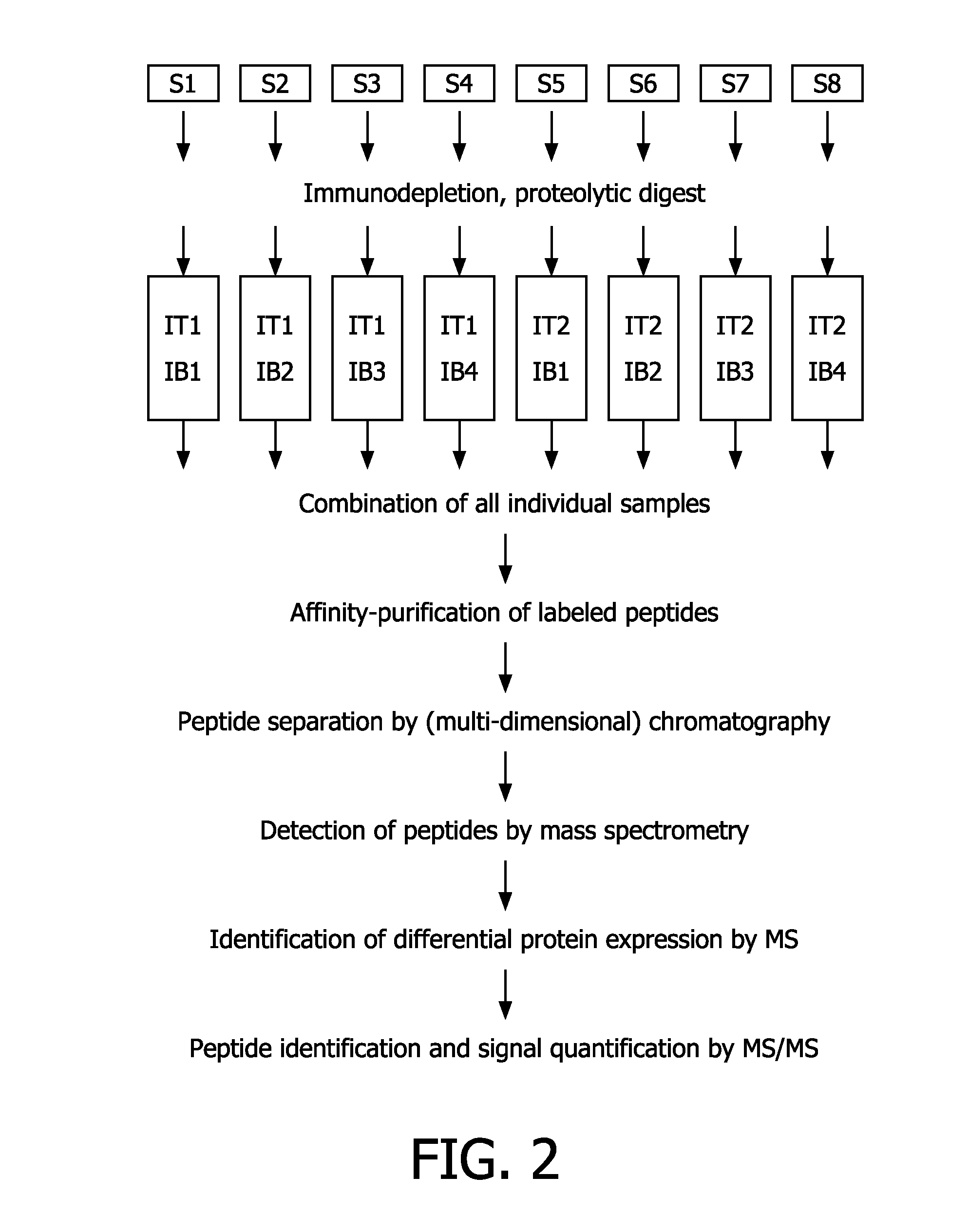Compounds and methods for the labelling and affinity-selection of proteins
a technology of protein affinity and compound, applied in the field of compound and method for the labelling and affinity selection of proteins, can solve the problems of a large amount of work, the complexity of the proteome exceeds that of the genome or the transcriptome, and the general tediousness of the research in this field
- Summary
- Abstract
- Description
- Claims
- Application Information
AI Technical Summary
Benefits of technology
Problems solved by technology
Method used
Image
Examples
example 1
Synthesis of a (Leu)3 Labeling Compound
[0115]The (Leu)3 labeling compound shown in FIGS. 4A and 6A was chemically synthesized according to the following protocol. The individual synthesis steps correspond to the reaction schemes depicted in FIG. 5.
[0116]Step (1): The starting materials (S)-2-(tert-butoxycarbonylamino)-4-methylpentanoic acid, (S)-methyl-2-amino-4-methylpentanoate hydrochloride, 1-(bis(dimethylamino)methylene)-1H-[1,2,3]triazolo[4,5-b]pyridine-1-ium-3-oxide hexafluorophosphate (V), and N-ethyl-N-isopropylpropan-2-amine were dissolved in dichloromethane (150 ml), 2.0 ml DMF were added and the mixture was stirred for 2 h, after which the Boc protected amine had disappeared (TLC eluens EtOAc / heptane 1:1). 150 ml of saturated ammoniumchloride were added, and the crude product was extracted with dichloromethane (8×30 ml). The organic layers were dried over sodium sulfate and concentrated under reduced pressure. The crude product was purified over a glass filter with silica...
example 2
Labeling of Peptides Using a (Leu)3 Labeling Reagent
[0127]In a pilot experiment, the (Leu)3 compound shown in FIG. 6A was used as a labeling reagent for labeling bovine serum albumin (BSA). FIG. 6A schematically illustrates the (Leu)3 compound comprising both the reporter ion and the balance group of the isobaric label component as well as a NHS-ester as the reactive group. Fragmentation sites in tandem mass spectrometry (MS / MS) are indicated by arrows.
[0128]For labeling, 50 mg bovine serum albumin was reduced (5 mM TCEP, incubation for 15 min at 56° C.) and alkylated (10 mM iodoacetamide, incubation for 30 min at room temperature in the dark); A batch of MC label (400 mg) was dissolved in 80 ml ethanol (3 ml were taken for separate mass spectrometric analysis of the label, cf. FIG. 6B) and subsequently added to the reduced and alkylated BSA. This mixture was incubated at room temperature for 2 hours.
[0129]After labeling, the buffer of the reaction mixture was exchanged to 100 mM am...
example 3
Biomarker Identification in Prostate Cancer
[0131]Prostate cancer (PCa) is the most common malignancy in European males. In 2002, in about 225000 men were PCa was newly diagnosed and about 83000 men died from this disease. PCa is diagnosed by histological examination of prostate tissue that is obtained by ultrasound guided transrectal biopsy. Indications for biopsy are predominantly an increased serum prostate specific antigen (PSA) and / or an aberrant digital rectal examination. PSA is the standard diagnostic and prognostic PCa marker. PCa awareness, leading to widespread use of PSA testing has led to a lower tumor stage and grade at the time of diagnosis.
[0132]However, the use of PSA is associated with certain drawbacks. First, an increase in PSA can reflect a benign as well as a malignant prostate disease, i.e. PSA is not cancer specific, resulting in a negative biopsy rate of 70-80%. Thus, a large number of patients is unnecessarily undergoing prostate biopsies. Such increased det...
PUM
| Property | Measurement | Unit |
|---|---|---|
| Time | aaaaa | aaaaa |
| Time | aaaaa | aaaaa |
| Time | aaaaa | aaaaa |
Abstract
Description
Claims
Application Information
 Login to View More
Login to View More - R&D
- Intellectual Property
- Life Sciences
- Materials
- Tech Scout
- Unparalleled Data Quality
- Higher Quality Content
- 60% Fewer Hallucinations
Browse by: Latest US Patents, China's latest patents, Technical Efficacy Thesaurus, Application Domain, Technology Topic, Popular Technical Reports.
© 2025 PatSnap. All rights reserved.Legal|Privacy policy|Modern Slavery Act Transparency Statement|Sitemap|About US| Contact US: help@patsnap.com



